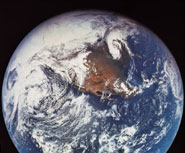The sensitivity of global temperature to changes in the Earth’s radiation balance (climate sensitivity) is a key parameter for understanding past natural climate changes as well as potential future climate change.
Many palaeoclimate studies have measured natural climate changes to calculate climate sensitivity, but a lack of consistent methodologies produced a wide range of estimates as to the exact value of climate sensitivity, which hindered results.
Now an international team of scientists, including Dr Dan Lunt and Professor Paul Valdes from the University of Bristol's School of Geographical Sciences and Dr Mark Siddall of Bristol's School of Earth Sciences, have developed a more consistent definition of climate sensitivity in prehistoric times.
When the scientists evaluated previously published estimates for climate sensitivity from a variety of geological episodes over the past 65 million years, they found that the estimates varied over a very wide range of values.
The team discovered that this wide range was almost entirely due to the fact that different researchers used different definitions. Just as biologists need taxonomy to ensure that they all talk about the same organisms, the climate scientists needed to develop a definition terminology that, applied to estimates from the past, makes those estimates compatible with estimates from climate models as used by the IPCC.
Having developed such a framework, the scientists then applied it to climate reconstruction data from the past 65 million years. This produced a much narrower range of estimates, defined in such a way that they could directly compare it with estimates in the IPCC assessment for their longer-term – that is, several centuries – outlook.
The study documented climate sensitivity over the last 65 million years and evaluated how realistic the IPCC's estimates are in that context. It found that the likely range of climate sensitivity consistently has been of the order of 2.2 to 4.8 degrees Centigrade per doubling of CO2, which closely agrees with the IPCC estimates.
Currently, atmospheric CO2 levels are around 392 parts per million (increasing by about 2.5 ppmv per year). Pre-industrial values were around 280 ppm, so that a doubling would therefore imply 560 ppm (at the current rate of emissions increase, this would achieve a doubling roughly around 50 to 70 years from now, but this depends strongly on the emissions developments).
Dr Lunt said: "It is amazing that natural archives of past climate change, for example tiny fossils in ancient ocean sediments or bubbles of air trapped in Antarctic ice, can usefully be used to evaluate model predictions of our future climate."
The research stems from a three-day Academy Colloquium attended by about 40 internationally renowned specialists in past and present climate studies, held at the Royal Netherlands Academy of Arts and Sciences in Amsterdam last year.
Paper
'Making sense of palaeoclimate sensitivity' by Rohling et al in Nature
